Ohio Wing Civil Air Patrol
The Ohio Wing (OHWG) of the Civil Air Patrol (CAP) is the highest echelon of CAP in the state of Ohio. The Ohio Wing headquarters are located in Columbus at the Defense Supply Center, Columbus. The wing is a member of the Great Lakes Region of the CAP.
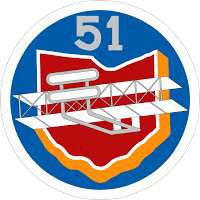 Ohio Wing of Civil Air Patrol | |
| Associated branches | |
|---|---|
| United States Air Force | |
| Command staff | |
| Commander | |
| Current statistics | |
| Cadets | 619 |
| Seniors | 613 |
| Total Membership | 1232 |
| Statistics as of May 5, 2020[1] | |
For the 70th anniversary of the Civil Air Patrol's founding, the Ohio Wing has created a special page on its World War II activities.[2]
History
The Ohio Wing's foundation corresponds with the late 1930s movement to organize civilian aviation for domestic defense. In 1940 in Toledo, Milton Knight organized a Civil Air Reserve unit. After taking office in 1939, Governor John W. Bricker appointed Cleveland resident Earle L. Johnson as Director of the Ohio Bureau of Aeronautics. A graduate of The Ohio State University, Johnson's interest in aviation began in the mid-1920s thanks to his neighbor and Cleveland native David Ingalls, the only United States Navy fighter ace from World War I. While working for Governor Bricker, Johnson in September 1941 organized Ohio's civilian pilots into a state Civil Air Defense wing. When the federal Office of Civilian Defense (OCD) established the Civil Air Patrol in December 1941, the state Civil Air Defense wing evolved into a CAP wing, with Johnson serving as the first wing commander. In March 1942, Johnson entered active army service and succeeded Major General John F. Curry as the national commander of the CAP, a position he held until his death in 1947.[3]
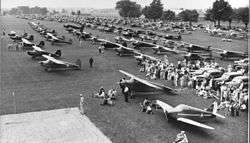
The Ohio Wing grew rapidly following the onset of the war. Under Johnson and later wing commander CAP Colonel George A. Stone, Jr., the wing recruited men and women throughout the state. Governor Bricker joined CAP in May 1942, as did Congressman John M. Vorys, himself a World War I naval aviator and former director of the Ohio Bureau of Aeronautics. By July 1942, the wing numbered 3,282 men and women organized in nine groups and 39 squadrons, making the Ohio Wing the third largest CAP wing in the nation; over 4,200 members served in the Ohio Wing by 31 October 1942. Ohio squadrons undertook a variety of missions on behalf of the war effort. The wing conducted statewide searches for scrap metal in response to OCD scrap drives for metal, tires, and other resources, saving countless hour of ground searches and locating well over a quarter million pounds of scrap metal. CAP squadrons also maintained constant aerial patrol over the state's valuable timber resources. The eagle eyes of Ohio CAP members prevented large forest fires from erupting in 1942. CAP personnel provided further surveillance of coal, oil, and gas resources in the state vital to the war effort and defense industries. Ohio wing members in 1943 volunteered to patrol flood-stricken areas across the state, radioing flood information to state and local authorities on the ground to help in responding to the emergencies. Other Ohio wing members served as aerial couriers during the war. The small light aircraft of CAP could ferry supplies vital for war effort into areas and through conditions when no other options remained viable.[4]
No mission, however, received the prominence of antisubmarine coastal patrol duty. Ohio, far removed from the U-boat menace, resolved to contribute to the coastal patrol effort. In July 1942, Representative Vorys made an open request for volunteers to help form an all-Ohio CAP Coastal Patrol base. On July 16, 1942, national CAP headquarters turned Congressman Vorys’ request into reality by authorizing the activation of Coastal Patrol Base No. 14 at Panama City, Florida. Columbus native Robert E. Dodge, a forty-one-year-old CAP major served as commander. The Ohio men established the base at an abandoned airfield four miles northwest of Panama City at St. Andrews Bay. Training on open water navigation, communications, and bombing practice commenced and the first patrols took off on August 8, 1942 over the Gulf of Mexico. From dawn to dusk, the CAP aircraft patrolled the warm waters of the gulf.
Sporting Donald Duck whimsically riding a flying bomb, the base's pilots patrolled an area of ocean from Mobile, Alabama to Light House Point, Florida, extending outwards of 60 miles from shore.[5] Aircrews spotted oil slicks, debris, reported suspected U-boats, remains of crashed aircraft, and anything out of the ordinary. Vorys himself flew patrol duty from August to September 1942, the only member of Congress to serve in the CAP coastal patrol. Although the Ohio men on patrol did not sink any U-boats, they assisted in the rescue of shipwreck survivors, reported sinking or suspicious vessels to the military, and ensured that the valuable tankers and supply vessels leaving ports in the Gulf made their way safely to military forces in Europe and the Pacific.[6]
On the evening of August 31, 1943 that the flag at Ohio's own Coastal Patrol Base No. 14 was lowered for the last time. The closure of the coastal patrol base did not end entirely in Florida, but rather California. In January 1944 the national CAP headquarters assigned some of the base personnel to Grand Central Air Terminal in Glendale, California to become Tow Target Unit No. 7, under the command of CAP Major Lloyd H. Fales, former command of Coastal Patrol Base No. 7, at Miami, Florida. Instead of spotting submarines, the pilots now towed large canvas sleeves at the end of a steel cable that could be played out via a winch up to 5,000 feet behind their aircraft. Pilots with considerable nerve and intestinal fortitude towed the targets while antiaircraft batteries practiced their marksmanship and target tracking and perfected their aerial gunnery procedures. Only the most powerful aircraft could pull the targets for daylight missions, while lighter aircraft flew tracking missions at night for searchlight tracking missions. By March 1945 the tow target mission was complete and the Ohio men returned to home to the Buckeye state, having joined CAP and seen the war. In 1948, the Department of Defense awarded Air Medals to any coastal patrol pilot or observer with over 200 hours of patrol time. Forty-three Ohio CAP members received the medal for their wartime service, the sixth highest total in the nation.[7]
Since World War II, the Ohio Wing has continued to prosper, developing scores of young men and women into model citizens and future personnel in the armed forces. Members of the wing have assisted in the rescue of downed aviators, provided assistance to state and national officials in natural disasters and local emergencies, and proudly represented the Birthplace of Aviation by promoting Ohio's aviation resources and heritage.
In January 2009, members of the Ohio Wing, along with CAP members from the Indiana, Illinois, and Kentucky Wings, flew sorties surveying damage and boosting communications for the Kentucky National Guard following a severe ice storm in Kentucky, while CAP ground crews assisted National Guardsmen in going door to door to perform wellness checks on residents.[8]
Annual encampment
The Ohio Wing holds a cadet encampment annually. Serving as a weeklong training camp for cadets, the encampment involves instruction in discipline, teamwork, and leadership. Other activities involve instruction in drill and ceremonies, customs and courtesies, basic CAP knowledge and military tradition. Encampment attendance is a prerequisite for the Gen. Billy Mitchell Award. Senior members may also be awarded the ribbon for providing leadership at CAP this encampment. The encampment is held at Wright-Patterson Air Force Base in Dayton, Ohio.[9][10]
Groups and squadrons
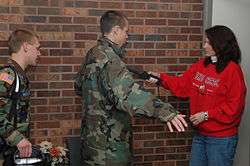
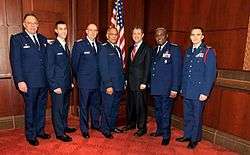
| Group | Number | Squadron name | Location | |||||
|---|---|---|---|---|---|---|---|---|
| Wing Headquarters | OH 001 | Ohio Wing Headquarters | Columbus | |||||
| OH 000 | Ohio Reserve Squadron | Columbus | ||||||
| OH 999 | Ohio Wing Legislative Squadron | Columbus | ||||||
| Group I | OH 044 | Group I Headquarters | Blue Ash | |||||
| OH 078 | Lunken Cadet Squadron | Cincinnati | ||||||
| OH 156 | Warren County Cadet Squadron | Lebanon | ||||||
| OH 244 | Lt Col James R. Sanders Senior Squadron | Blue Ash | ||||||
| OH 279 | Clermont County Composite Squadron | Batavia | ||||||
| OH 288 | Pathfinder Cadet Squadron | Middletown | ||||||
| Group III | OH 254 | Group III Headquarters | North Canton | |||||
| OH 051 | Youngstown ARS Composite Squadron | Vienna | ||||||
| OH 096 | 96th Composite Squadron | Stow | ||||||
| OH 177 | Mansfield Squadron | Mansfield | ||||||
| OH 219 | Medina County Skyhawks Composite Squadron | Wadsworth | ||||||
| OH 275 | Akron-Canton Senior Flying Squadron | Green | ||||||
| OH 278 | Akron-Canton Composite Squadron | North Canton | ||||||
| Group IV | OH 058 | Group IV Headquarters | Cleveland | |||||
| OH 003 | Lorain County Composite Squadron | Elyria | ||||||
| OH 131 | Cuyahoga County Cadet Squadron | Brecksville | ||||||
| OH 236 | Lakefront T-birds Composite Squadron | Cleveland | ||||||
| OH 252 | Frank H. Kettlewood Composite Squadron | Painesville | ||||||
| Group VI | OH 064 | Group VI Headquarters | Bowling Green | |||||
| OH 016 | Toledo ANGB Composite Squadron | Swanton | ||||||
| OH 018 | Perrysburg Senior Flight | Perrysburg | ||||||
| OH 231 | Grand Lake Flight | Celina | ||||||
| OH 298 | Lt Jacob Parrott Composite Squadron | Lima | ||||||
| OH 801 | Sandusky High School Cadet Squadron | Sandusky | ||||||
| Group VII | OH 043 | Group VII Headquarters | Wright-Patterson AFB | |||||
| OH 037 | Wright-Patterson Composite Squadron | Wright-Patterson AFB | ||||||
| OH 114 | Don Gentile Composite Squadron 709 | Piqua | ||||||
| OH 197 | Dayton Aero Cadet Squadron 706 | Troy | ||||||
| OH 282 | Wright Brothers Composite Squadron | Dayton | ||||||
| OH 284 | Miami Valley Composite Squadron | Miamisburg | ||||||
| OH 285 | Dayton Senior Squadron | Wright-Patterson AFB | ||||||
| Group VIII | OH 291 | Group VIII Headquarters | Columbus | |||||
| OH 085 | Columbus Senior Squadron | Columbus | ||||||
| OH 115 | Capt Eddie Rickenbacker Composite Squadron | Whitehall | ||||||
| OH 139 | Columbus Composite Squadron | Worthington | ||||||
| OH 157 | Licking County Composite Squadron | Newark | ||||||
| OH 210 | Rickenbacker ANGB Squadron | Columbus | ||||||
| OH 234 | Victor A. Hammond Composite Squadron | Marysville | ||||||
| OH 243 | Ross County Senior Squadron | Chillicothe |
Wing commanders
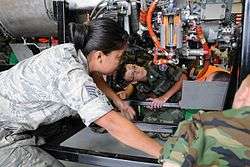
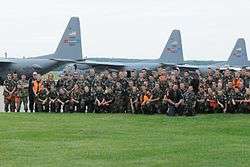
| Commander's name | Period of service |
|---|---|
| Earle L. Johnson* | December 1, 1941 – April 1, 1942 |
| Col George A. Stone, Jr. | April 7, 1942 – June 1, 1947 |
| Col John R. McGuire | June 1, 1947 – July 17, 1951 |
| Col Edmund P. Lunken | July 17, 1951 – September 23, 1953 |
| Col John O. Swarts | September 23, 1953 – September 14, 1957 |
| Lt Col Lyle W. Castle | September 14, 1957 – August 12, 1960 |
| Col Robert H. Herweh | August 12, 1960 – December 6, 1963 |
| Col William W. Kight | December 6, 1963 – December 8, 1967 |
| Col Patrick R. Sorohan | December 8, 1967 – June 1, 1970 |
| Col Gerald M. Tartaglione | June 1, 1970 – June 1, 1974 |
| Col Leon W. Dillon | June 1, 1974 – January 4, 1978 |
| Col Claude H. Fore, Jr. (interim) | January 4, 1978 – December 1, 1978 |
| Col Marjorie J. Swain | December 1, 1978 – February 20, 1983 |
| Col Loren G. Gillespie | February 20, 1983 – May 6, 1987 |
| Col Larkin C. Durdin | May 6, 1987 – December 31, 1989 |
| Col Leslie S. Bryant | December 31, 1989 – January 1, 1992 |
| Col Carl C. Stophlet, Jr. | January 1, 1992 – October 1, 1994 |
| Col Jacquelyn L. Hartigan | October 1, 1994 – September 19, 1998 |
| Col Robert M. Sponseller | September 19, 1998 – August 4, 1999 |
| Col Michael J. Murrell | August 4, 1999 – September 14, 2003 |
| Col Charles L. Carr, Jr.* | September 14, 2003 – March 1, 2007 |
| Col Dave Winters (interim) | March 1, 2007 – June 6, 2007 |
| Col Dave Winters | June 6, 2007 – June 11, 2011 |
| Col Gregory L. Mathews | June 11, 2011 – June 23, 2013 |
| Col Theodore L. Shaffer | Oct 13, 2013 – Oct 14, 2017 |
| Col David J. Jennison | Oct 14, 2017 – Present |
* denotes commanders who have gone on to become the national commander of the Civil Air Patrol.
References
- "eServices, National Headquarters". Civil Air Patrol., login required
- Blazich, Frank. "Ohio Wing of the Civil Air Patrol in World War II – A Brief Overview". ohwg.cap.gov. Ohio Wing, Civil Air Patrol. Retrieved March 8, 2012.
- "Civil Air Patrol Commander, Two Others Killed in Crash," The Washington Post, 17 February 1947.
- "Civil Air Patrol Volunteers Comb the Clouds for Uncle Sam," The Columbus Sunday Dispatch, July 26, 1942.
- "Robert E. Arn". Mywarhistory.com. Retrieved March 8, 2012.
- Louis E. Keefer, From Maine to Mexico: With America's Private Pilots in the Fight Against Nazi U-Boats. Reston, V.A.: COTU Publishing, 1997, pp. 316-45.
- National Historical Committee (1984). "Civil Air Patrol Historical Monograph: Air Medal" (2). Headquarters CAP. Cite journal requires
|journal=(help) - "Ice Storm Puts Kentucky in Deep Freeze" (PDF). Capmembers.com. 2009. Retrieved November 4, 2015.
- "2012 Ohio Wing Encampment". encampment.ohwg.cap.gov. Ohio Wing, Civil Air Patrol. Retrieved March 8, 2012.
- "Encampment Location". encampment.ohwg.cap.gov. Ohio Wing, Civil Air Patrol. Retrieved March 8, 2012.
- "Units". ohwg.cap.gov. Ohio Wing, Civil Air Patrol. Retrieved March 8, 2012.
